Muse Pi Pro is a feature-packed, credit card-sized SBC powered by the SpacemIT M1 octa-core 64-bit RISC-V AI SoC with a 2 TOPS NPU and equipped with up to 16GB LPDDR4x and 128GB eMMC flash.
The single board computer features gigabit Ethernet and a WiFi 6 + Bluetooth 5.3 module for connectivity, HDMI and MIPI DSI display interfaces, two MIPI CSI interfaces, a 3.5mm audio jack, four USB 3.0 ports, an M.2 socket for an NVMe SSD or wireless module, a mini PCIE socket for WiFi and 4G LTE/5G cellular connector, and a 40-pin GPIO header for expansion. That’s quite a lot of features for such a compact board.
Muse Pi Pro specifications:
- SoC – SpacemiT M1 (similar to SpacemIT K1, but clocked at 1.8 GHz)
- CPU – 8-core X60 RISC-V processor @ 1.8 GHz
- GPU – Imagination IMG BXE-2-32 with support for OpenGL ES3.2, Vulkan 1.2, OpenCL 3.0; 20 GFLOPS
- VPU – H.265 and H.264 1080p60 decoding/encoding
- NPU – 2.0 TOPS (INT8) AI accelerator
- RVA 22 Profile RVV 1.0 compliant
- System Memory – 8GB or 16GB LPDDR4X @ 2,400 MT/s
- Storage
- 64GB or 128GB eMMC 5.1 flash
- MicroSD slot (UHS-II)
- M.2 M-Key 2230 socket for NVMe SSD
- Display I/F
- HDMI 1.4 up to 1080p60
- 2-lane MIPI DSI up to 1080p60 via 15-pin FPC connector
- Camera I/F
- 4-lane MIPI CSI via 22-pin FPC connector
2-lane MIPI CSI via 15-pin FPC connector
- 4-lane MIPI CSI via 22-pin FPC connector
- Audio – 3.5mm audio jack
- Networking
- Gigabit Ethernet RJ45 port
- Wi-Fi 6 & Bluetooth 5.2 module with two u.Fl antenna connectors
- Support for additional wireless/cellular module via M.2 or mPCIe socket
- USB
- 4x USB 3.0 Type-A ports
- 1x USB 2.0 Type-C OTG port
- Expansion
- M.2 M-Key socket (PCIe 2.1 x2); used for storage, wireless, or other modules
- Full-size miniPCIe socket (PCIe 2.1 x1) for 4G LTE/5G, PCIe network modules
- 40-pin GPIO header (mostly compatible with Raspberry Pi GPIO header)
- Debug – UART TTL debug port
- Misc
- Reset, power, and flash (FEL) buttons
- RTC battery connector
- Optional
- Power Supply – 5V/9V/12V up to 3A via USB-C port (USB PD compliant)
- Dimensions – 85×56 mm (Raspberry Pi/credit card form factor. The company also calls this a FEMTO-ITX board.)
- Temperature Range
- Consumer-grade – -20°C to 70°C
- Industrial-grade – -40°C to 85°C
- Reliability – ESD: ±4kV contact / ±8kV air
- CE/FCC compliant
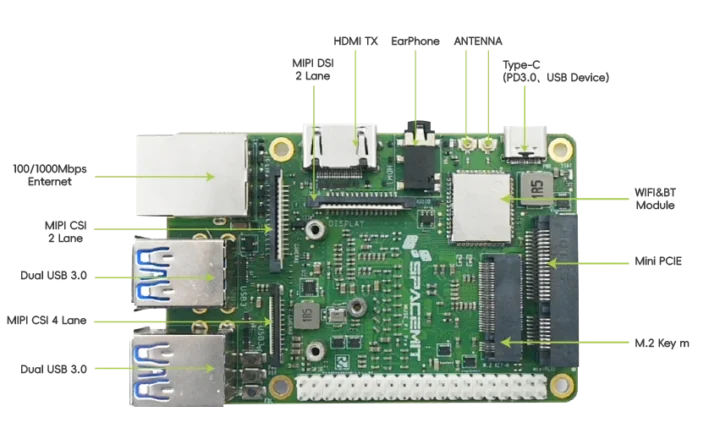
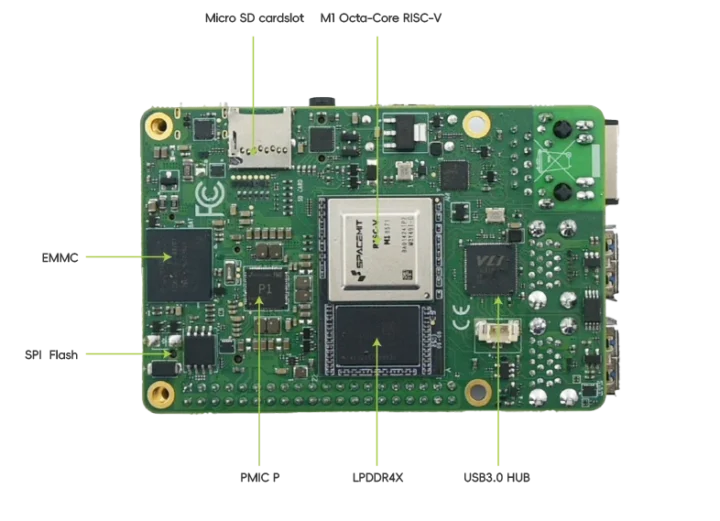 Software size, the Muse Pi Pro is said to support Bianbu Desktop (as reviewed with the Jupiter mini-ITX SBC with the same SoC), Ubuntu, OpenKylin, Deepin, Fedora, and others. However, the documentation website (available in Chinese and English) only provides instructions for the Ubuntu-based Bianbu Desktop OS, and looking at the download directory, I can also see minimal and NAS images for the board.. Having said that, UEFI support (section 4 of the user guide) would explain why they claim support for a long list of operating systems.
Software size, the Muse Pi Pro is said to support Bianbu Desktop (as reviewed with the Jupiter mini-ITX SBC with the same SoC), Ubuntu, OpenKylin, Deepin, Fedora, and others. However, the documentation website (available in Chinese and English) only provides instructions for the Ubuntu-based Bianbu Desktop OS, and looking at the download directory, I can also see minimal and NAS images for the board.. Having said that, UEFI support (section 4 of the user guide) would explain why they claim support for a long list of operating systems.
Despite its name, the Muse Pi Pro looks to be a cost-down/smaller version of the Muse Pi board introduced earlier. Note that most RISC-V SBCs should only be considered developer boards, unless you use them for headless applications without the need for graphics and video acceleration, since software support is still a work-in-progress, and your mileage may vary.
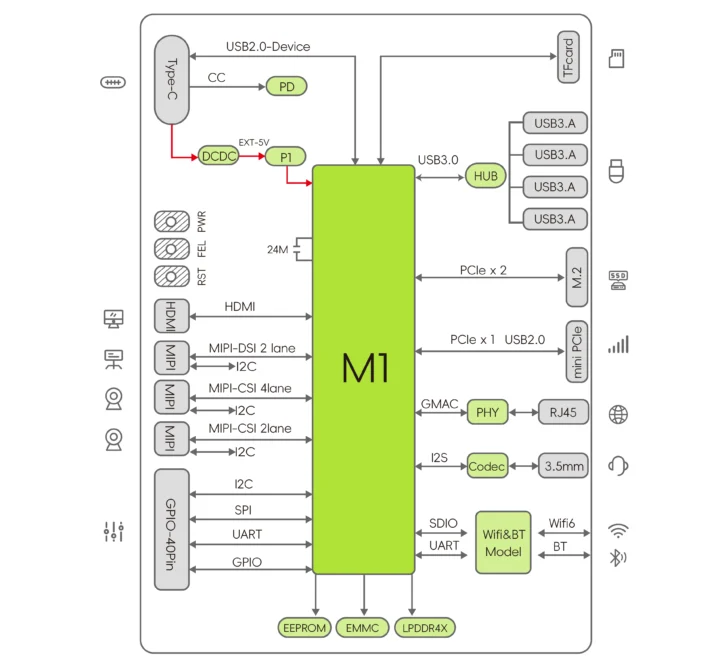
The Muse Pi Pro SBC can be purchased on AliExpress for $122.42 in 8GB/64GB configuration without cooling. There are multiple options/bundles, including a full kit with a touchscreen display, a heatsink, and the 64GB/128GB board that goes for about $180. The seller on AliExpress (Chip Board House Store) is most likely not the manufacturer, and the company usually resells boards from manufacturers with a markup, so you could save a few dollars by waiting until it is sold through an official channel. In any case, the performance/price ratio will still not be at the level of Arm-based equivalents, unless you make use of all the board’s features.
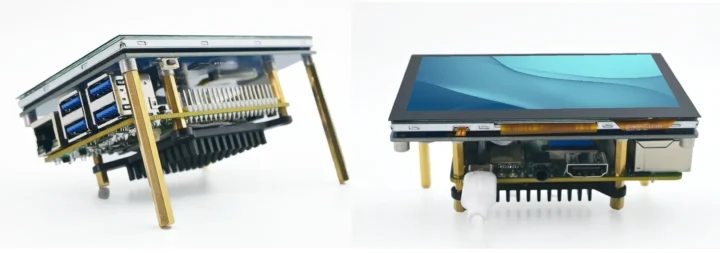

Jean-Luc started CNX Software in 2010 as a part-time endeavor, before quitting his job as a software engineering manager, and starting to write daily news, and reviews full time later in 2011.
Support CNX Software! Donate via cryptocurrencies, become a Patron on Patreon, or purchase goods on Amazon or Aliexpress


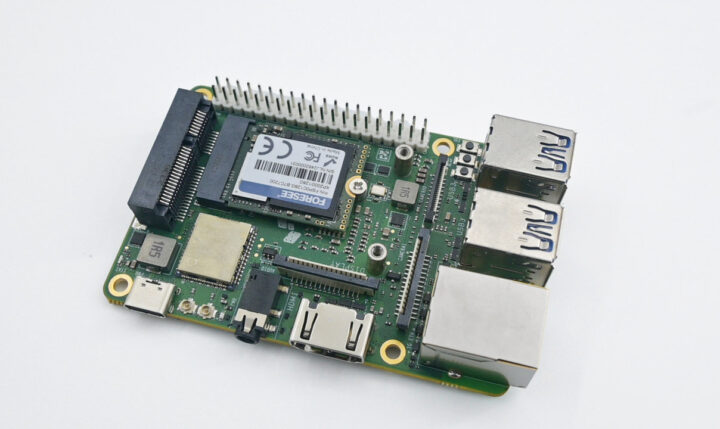



So more expensive than the Banana Pi BPI-F3. That’s a bold proposition.
The boards are offered with different memory/storage capacities, though. The BPI-F3 has 2GB/8GB or 4GB/16GB models, while the Muse Pi Pro starts at 8GB/64GB.
I forgot about the Orange Pi RV2 that sells for $50 with 8GB RAM (but no storage). A 64GB microSD card adds about $10 to $15.
The Muse Pro page has been removed from AliExpress.